Dracula X: Rondo of Blood
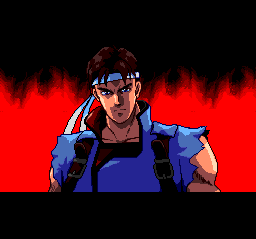
During the years that have passed since scattered, hapless TurboGrafx-16 fans began clamoring for the game's stateside release in 1993, Rondo of Blood has watched its legend grow to mythical proportions. American players still covet Castlevania's elusive PC Engine chapter, and the CD still commands high prices on auction and import sites, costing collectors an arm and a leg should they simply wish to discover what all of the fuss is about. Surely, the masterminds responsible for the production of the title had no idea that it would eventually carry such fame and mystique, and indeed, how could they have? Rondo of Blood, for all intents and purposes, revisits and fine-tunes the 8-bit action-platformer episodes that the series kicked off with, as if to perfect a project that could not have been completed as desired given the then-available hardware. While appealing, the concept certainly seems simple enough; and as a matter of fact, the hype surrounding the game has served to shroud its true nature.

People have become more interested in witnessing a legend in action than in taking the adventure for what it is, which is truly a shame, as Rondo harkens back to the days when one could spend all night glued to the television set, unearthing secrets and experiencing unparalleled drama in adventures that would retain their appeal for a lifetime. With all of the superficial perfection that this CD Castlevania exudes, it’s the feelings of excitement, intensity, and power that it inevitably evokes that make it such a special game. It epitomizes excellence and stands as a high point in a once-prominent genre. In these respects, Rondo of Blood can be viewed not only as Konami’s magnum opus but also as one of the masterpieces that serve to define an entire era of gaming.
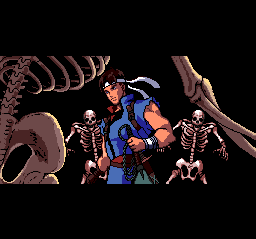
Standing tall in the center of this drama is slick Richter Belmont, usurper of the title “Vampire Hunter” from his old, washed-up ancestor, Simon. In keeping with the “in with the new” philosophy, Richter has disposed of Simon’s horrid brown rags and dusty, inadequate equipment, decking himself out in a sleek blue suit and carrying by his side a serpent of a whip in need of no morning stars to do its deadly damage. But Richter knows better than to fix things that aren’t broken; hence, all of the crosses, axes, and flasks of holy water that Simon once wielded as auxiliary weapons are available to our young hero as he sets off to defy Death and take down the Count.

Unlike Simon, the perennial loner, Richter is a stud through and through, and four young ladies imprisoned in Dracula’s castle impatiently wait for him to come to their rescue. Finding them won’t be easy, however; Rondo is not of the same linear ilk as many of its predecessors. Multiple paths and alternate stages await Richter as he hunts for the Count, and indeed, some hidden niches are more elusive than others. Still, Richter is not the type that allows helpless captives to remain trapped in hellish places, and repeated castle visits will be the only way for our persistent Belmont to garner whatever rewards the prisoners might offer him. "Hotties" aside, the true treat comes when Richter stumbles upon the fourth damsel in distress, a spunky young girl named Maria.
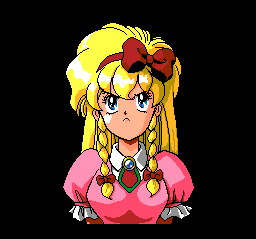
A veritable blonde ball of excitement, Maria takes quite a bit of crap from Richter when she first expresses her desire to join him on his quest. It doesn’t take long, though, for Richter to realize that the munchkin really means business and that she’s just as determined to take down the “mean man” known as Dracula as our noble hero himself. It’s a good thing he ultimately allows her to tag along, as Maria has a few tricks up her sleeve that Richter could only dream of pulling off. Once you've rescued her, you'll be able to play as Maria if you so desire, and an entirely new arsenal will be at your disposal. Whereas Richter stubbornly sticks with the Belmont whip when participating in battle, Maria hurls fierce little doves at her foes. Richter’s axes and daggers and whatnot are replaced by additional animal allies, including courageous felines and impressive green dragons. Maria can’t take as much of a beating as the hulkish Richter can, but she is able to avoid attacks more easily due to her small frame, and she's actually the better character to use during later stages, as she can call on her pals to either dole out a beating or aid her in outwitting her enemies.
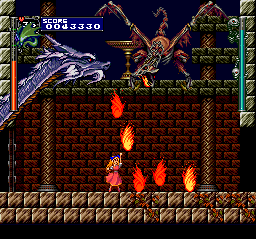
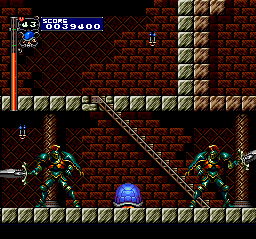
Whichever character you choose, and regardless of the differences in style between the two, Rondo of Blood will continually call to mind the old 8-bit carts that many aspiring action-game pros grew up on. Think back to the first glimpse you had of the town of Veros in Simon’s Quest, its buildings standing complacently, their drab brick walls exuding mocking apathy as the Vampire Hunter set off on his mission. Veros is revisited here, as is the zombie-ridden hallway that served as an introduction to the series for players who experienced the very first chapter on the NES. Speaking of the original episode, all of those classic bosses that gave players fits back in the day--the giant bat, Medusa, the mummy, and Frankenstein himself--have returned to pay their respects.
Of course, this is no old-cart platformer. Pushing the Duo to its limits, Rondo of Blood takes all of those familiar scenes and morphs them into brutal portraits of unabated horror. Those buildings in Veros are now exploding in brilliant, enormous flames, finally succumbing to the evil that they had seemed so very indifferent to all those years ago. Skeletal beasts launch their initial attacks while gargantuan stone golems roam the streets, looking to pound on Richter with fists that alone match the hero in size (not bad for an opening level, eh?). Zombies will still assail you when you first set foot in the castle, but now you’ll see rain pouring down and bats fluttering about beyond the window panes, while a gigantic bull, unfazed by the decaying flesh on its blood-drenched bulk, pursues you relentlessly. And those old bosses? Yes, they’re back, and this time you will have to slay them one after another--without dying.
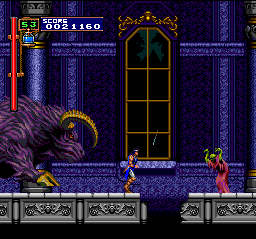

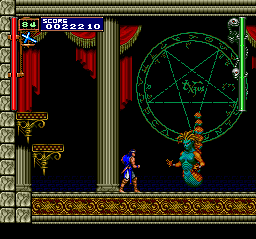
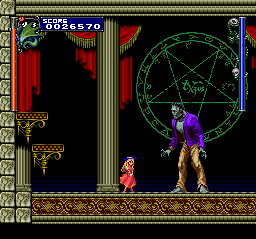
Rondo of Blood is not simply excellent in parts; the aforementioned scenes are indicative of what awaits you throughout the entire quest. The most-thrilling moments come during boss encounters, as Dracula’s behemoths have long abandoned the mundane methods of attack they'd utilized in previous episodes. Konami knew exactly how to create tension and drama, and in few other games of any genre will you feel the sorts of intensity and excitement that characterize the fights with level leaders in Rondo. A werewolf kneels on a platform high above the ground and slowly rises as you approach, its frame creating a daunting silhouette against the full moon in the background. Releasing a loud, menacing howl, the beast leaps down to engage you in battle. Later, stonework structures suddenly collapse behind you, trapping you in a room where a door bursts open, revealing vicious, glowing eyes. A colossal minotaur steps out from the darkness, wielding an axe twice Richter's size. Eventually, you’ll discover a long, sharp lance that suddenly rises and spins, finally coming to rest in the hands of the newly materialized Sir Dullahan, a headless knight. Just before the final confrontation with Dracula, you'll have to defeat the fierce wizard Shaft, who summons terrifying undead giants that soar through the skies while exhaling fire and crash through the ground with enormous horns. And the inevitable confrontation with Death assumes the form of an epic battle aboard a ghost ship and culminates with decapitation.
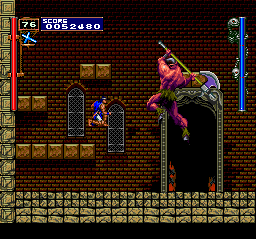

The bosses aren’t the only villains who receive the royal treatment. Axemen here carry shields to thwart your missile attacks and occasionally rush forward to hack you up the old-fashioned way. Knights don’t simply patrol the halls; they twirl their lances and take vicious shots that send your character reeling across the screen. Bone dragons are now the large, serpentine monstrosities that one imagines they were always intended to be.
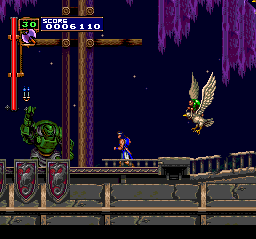
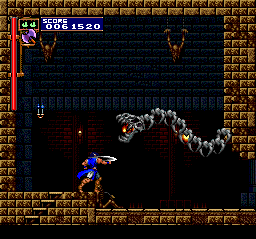
While revisiting the classics clearly paid off in many ways for Rondo, the old, clunky controls employed by said classics simply wouldn’t suffice with Richter and Maria up against such a fearsome cast of villains. No longer will “triple-shot boomerang and a prayer” be one’s only hope for beating Death; the wherewithal is finally provided for one to utilize tactical strategy while battling Dracula’s right-hand man and dodging his limitless sickles. The fundamental button functions here call to mind old Castlevania control schemes, but these fresh-faced heroes are much more athletic and agile than their forefathers were, having taught themselves new jumping techniques and methods of evading enemy attacks as well as graphically appealing “item crashes,” which spew veritable storms of weaponry at Dracula's minions.
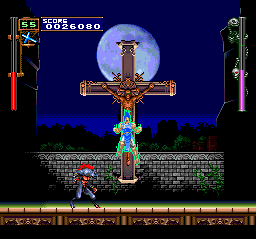
Aside from the gloriously well-drawn behemoths, Rondo succeeds visually with deep parallax scrolling and fantastic character animation (witness Maria’s hair blowing in the wind as she runs and jumps). Scaling effects flaunted by Super Castlevania IV obviously aren’t present here, but the visuals are extremely sharp and the colors utilized (which often are quite reminiscent of Gate of Thunder's despite the obvious differences in the games) are brighter and bolder than those displayed by any other episode released prior to or during the 16-bit era.


Many old musical favorites are offered up and presented in fantastic CD-quality sound. The experience of listening to “Bloody Tears” is heightened by the emotional interlude that occurs between the standard riffs we are all familiar with. “Cemetery” starts off melodically only to erupt into a Doors-like chorus of chaos propelled by the pummeling a snare drum receives. All instruments involved in the track that accompanies boss battles come into play simultaneously with a single explosive chord and drive horror-induced riffs for the duration of each fight. While Super Castlevania IV excels with subtle, eerie tunes, Rondo of Blood tosses forth hard-edged tracks that are relentless and ripping with intensity. The only drawback is that there are few original numbers featured here, whereas SCIV contains many.
Rondo is a relatively short game, with the non-stop excitement and drama making it feel all the more compact. Individual levels fly by since there constantly are battles to be waged, secrets to be discovered, and traps to avoid. It’s inevitable that one will utter upon completing the job, “It’s over... already?” Nonetheless, the game is so enjoyable that it will undoubtedly remain alluring even after one has beaten it multiple times.
But to be frank, there are other, more-significant chinks in Rondo’s armor. The modern game I often compare it to is God of War, as it relies so heavily on theatrics for its appeal. The bosses make grand entrances, thrash about noisily with grunts and yells and flashy antics, and go out with huge bangs; but many of them, including the aforementioned golems and even the final boss himself, are so inept in battle that they essentially act as large, defenseless entities that can be systematically annihilated. The presentation is excellent and does more to make the game feel exciting than the actual challenges themselves.
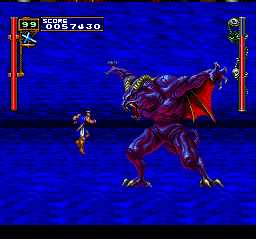
Rondo contains theatrical brilliance, for sure, but as can be said of God of War, there are other games out there with action that's more intense and adventuring that's more substantive--including, in Rondo's case, some of its fellow old-school Castlevania episodes. SCIV flaunts a truly evolved control scheme and achieves a very eerie atmosphere, while Rondo basically just polishes up the old 8-bit maneuvers and is merely kind of "cool." And surprisingly enough for a game that depends so much on flash (and excels with the approach for the most part), Rondo's cinemas feature little impressive artwork and but a few memorable moments, with some poorly drawn scenes actually looking rather appalling.
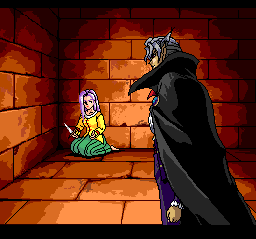

Flawed it may be, but Rondo of Blood, when taken for what it is, is still one of the greatest 2D action-platformers ever released. A veteran of the genre will appreciate the title far more than modern-day ham-and-eggers adore their new first-person shooters and shouldn’t hesitate to fork over the significant sum of cash it will undoubtedly cost. One of the most wonderful of yesteryear's adventures, it’s a video game that will not be forgotten soon after it’s been beaten. And that is Rondo of Blood’s true claim to fame.

